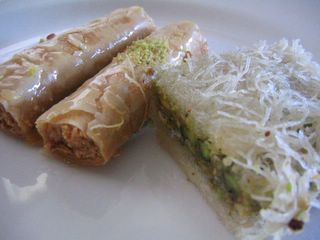Baklava Trivia: It's believed that Baklava has its origins from Assyria around the 8th century B.C. Wow, Baklava's older than Jesus. That's amazing. The dessert was spread to other Middle Eastern and Mediterranean civilizations throughout time, and went through many evolutions as it went from culture to culture. As the Greeks got hold of it, the pastry used to make Baklava became thinner and the use of Phyllo (meaning "leaf" in Greek) came into play. Betcha didn't know all that, huh? Good, now go and try to impress all your friends.
I've had baklava a couple of times in my life, always a piece or two given to me by a friend, so I was utterly unaware that there were so many different kinds. That is, until I walked into this small but airy North Hollywood mini-mall storefront where I was greeted a counter full of various miniature phyllo-dough concoctions. Peering through the plexi-glass "sneeze-shields", I pondered the sea of varying golden brown and pistachio green patterns for a moment. Unsure which ones to pick, I figured that for $7.50 a pound, I could get quite a few combinations of phyllo and nuts.
I asked the Baklava Lady to guide me and point out their most popular goods. I walked out with a plastic takeout container filled with a variety of treats...Traditional Walnut and Pistachio Baklava: cubes of phyllo dough layered with ground walnuts or pistachios drizzled with sugar syrup, Baklava fingers: rolled phyllo dough stuffed with ground cashews drizzled with syrup, Birds Nests: little purses of phyllo filled with walnuts or pistachios drizzled with syrup, Ballourie: cubes of kataifi (shredded phyllo) layered with pistachios and drizzled with rosewater, Burma: a shredded phyllo wrapped around chopped pistachios made to look somewhat like a cut sushi roll, and Kataifi Baklava: a Kellogg's Shredded Mini Wheat looking thing made of baked kataifi wrapped around ground pistachios.

Traditional Baklava

Baklava Fingers and Balourie

Birds Nests

Kaitafi Baklava or Kellogg's Mini Wheats?
Honestly, all the baklava kinda tasted the same to me. All were plays on the same few ingredients, each formed a little differently to give slightly different textures. They were all crispy and flaky from the phyllo (I'm still picking the crumbs out of my lap), and really sticky sugary-sweet. Almost too sweet for my taste. Made my cavities hurt. Perhaps this is how dentistry got started too? The Balourie (Baklava drizzed with rosewater) was probably the most unique tasting baklava of the bunch from the addition of rosewater, but it almost tasted like you were eating a bottle of your grandma's perfume. Not for me. The Baklava Fingers were probably my favorite as they were the most delicate and the syrup wasn't as overpowering.
Note to self for next time: eat only one or two pieces and have with black coffee!
The Baklava Factory
12909 Sherman Way
North Hollywood, CA 91605
(818) 764-1011




3 comments:
pam,
baklava's origin is correct though the ones who got hold of it are Turks.
baklava and related desserts are my favorite, wish you could taste "original baklava of gaziantep city (in Turkey) full of walnut or pistachio which is so thin that melts in mouth type
nice blog by the way
THIS AMAZING LEBANESE PLACE NEAR ME IN QUEENS NEW YORK MAKE BAKLAVA WITH ROSEWATER! AMAZING!
The original baklava recipe IS with rosewater (but many do not like that taste, so they put honey, lemon, orange etc.). Turks have hundreds of tyoes of baklava. It is amazing ..and veryyyy sweet :)
Post a Comment